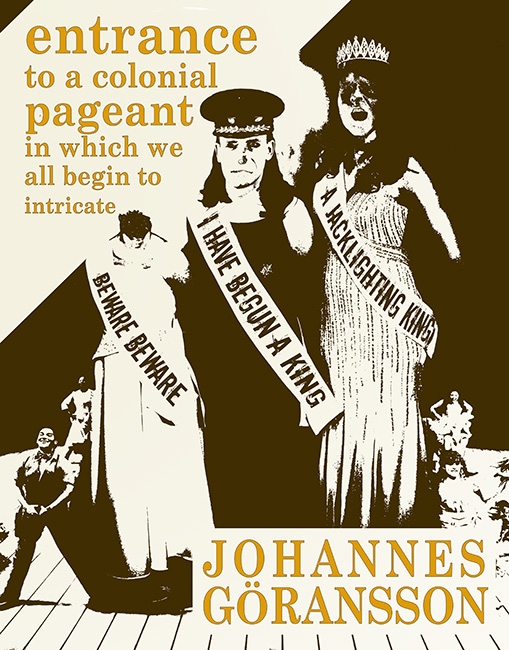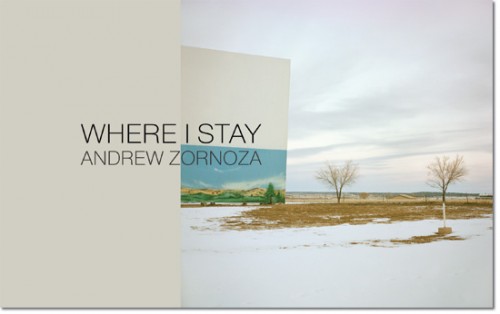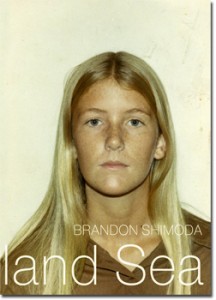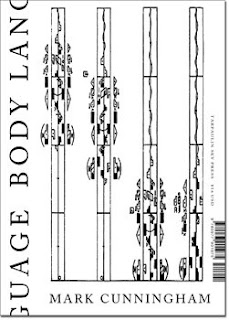I Want It All To Be Kind of Shitty: An Interview with Johannes Göransson

I can’t say enough about how important the work of Johannes Göransson has been to me, both as a field of language and image, and as a person. Besides co-editing both Action Books and Action Yes, two places where you can always depend on reading work that is new, singular, challenging, and actually fun, he has published four full length books of his own work, including Dear Ra, A New Quarantine Will Take My Place, Pilot, and most recently Entrance to a colonial pageant in which we all begin to intricate from Tarpaulin Sky, as well as translations of important Swedish writers like Aase Berg and Johan Jönsson [if you haven’t read his Swedish issue of Typo, holy shit], and wrangling of the insane machine that is the hybrid litblog Montevidayo. Not to mention being a teacher (which, when reading some of his students’ work, and what mechanisms he gets out of them so early, equals a particular feat), a father, a husband, and a person. In no small words, a fucking force.
Over the past few weeks I exchanged emails with Johannes about all of the above and more.
* * *
BB: I remember reading pieces of the Pageant years ago I think under the name New Torture Operations, yeah? How did this project begin and manifest itself into the book it is, on an assemblage level?
JG: Yes, I think that was one early version of what became, among other things the pageant. It also became the second half of the performance piece The Widow Party and my novel Haute Surveillance (which is not published). Assemblages do play a big part in the way I compose these. In part they come out of a piece I wrote over a couple of years a few years ago, The Black Out Sessions or The Secessions (it has many names), and which I haven’t and won’t publish (well I did publish some of them before deciding that it wasn’t the right thing to do), but from which I create various assemblages – such as in The New Torture Operations, The Widow Party and Pageant, all of which form assemblages between torture and fashion, the anorexic body and performance, atrocity and kitsch, colonialism and the nuclear family.
When I was working on these Black Out Sessions I was also studying Brazilian-Swedish artist-poet Oyvind Fahlstrom’s work from the 1950s and 60s and he uses this funny pun – he doesn’t make “collage,” he says he makes “kalas,” which is Swedish for “party”. And the way this works out is that his artworks parties (though it’s usually translated as “feast”) on other works of art or texts. So there’s a party on Mad Magazine, or a party on Burroughs etc. So the Black Out Sessions were parties on just about anything I could find. I was both very creative and totally unfocused so I decided this wasn’t a finished text but something that I would party with/against/on with these other manuscripts. The Black Out texts became a kind of “party” energy which I used on other texts and subject matters to form assemblages. In the particular pieces that are in The New Torture Operations and pageant are parties on this 19th century antique textbook a student gave me years ago – what every student needs to know about the world. This includes chapters on astronomy, “The Vasty Deep,” and “The Flowery Kingdom” (China). A lot of what a student needs to know, it turns out, is about the morality of various colonial ventures (Stanley and Livingston get their own full chapter). Interestingly my home country of Sweden gets I think one sentence in a paranthesis and it’s something like “… (in difference to the Scandinavian countries, about which not much is known other than that they are the ugliest and least intelligent of people).”
June 2nd, 2011 / 1:15 pm
Notes on Johannes Göransson’s Pageant

I first read Johannes Göransson’s Entrance to a colonial pageant in which we all begin to intricate (Tarpaulin Sky, 2011), on a rickety train moving westward from South Bend, Indiana, to Chicago during the recent blizzard. The ride, which usually takes 2.5 hours or so, stretched into a nearly 4 hour-long, thunder-snow tour of rust belt America. This is not a review. This is a context.
As we chugged through locales such as Michigan City, Indiana, and Gary, I set my reading of this book on repeat. The book, itself a hybrid form somewhere between or among the categories of poetry, prose, essay, theatre production, and instruction manual, is also an exercise in engaging with the fluidity of self. Riding the train in such conditions, one identifies with the character of THE PASSENGER who states, acts, or otherwise embodies the following words in its opening salvo:
I was admitted. I had to answer questions. Are you gay? Are
you a terrorist? Are you a communist? I answered No to all the
questions. After a while I started noticing that the questions had
changed. What do insects have to do with cinema? Can you hear
me? Are we underwater? Can I kick you in the face? Why do
your spasms look infantile? Do you know how to break a radio?
But I kept answering No. Because that’s what I wanted to hear
myself say with that bag over my face
and also is embodied by THE NATIVES who “ask these questions of the most beautiful people they can find in a mall”:
February 28th, 2011 / 7:21 pm
“it had this varnish all over it / we got this varnish all over us”
 Deeply excited to spread of word of Emily Toder’s Brushes With, which is a little book about meeting shapes that’s coming out from Tarpaulin Sky. Stop shaving your home bases and practicing the same three chords and have a look at this. Excerpt after the jump:
Deeply excited to spread of word of Emily Toder’s Brushes With, which is a little book about meeting shapes that’s coming out from Tarpaulin Sky. Stop shaving your home bases and practicing the same three chords and have a look at this. Excerpt after the jump:
Trickhouse | TSky
The New TSky is the New Trickhouse
Tarpaulin Sky #16
Summer 09:
TrickhouseThe current issue of Tarpaulin Sky is the current issue of Trickhouse; i.e., the current issue of Trickhouse is the current issue of Tarpaulin Sky. Think of it as Trick Sky or Tarp House. Or just don’t worry about all that, and instead proceed directly to the goods:.
Trickhouse Vol. 5 / Tarpaulin Sky #16
Curated by Noah Saterstrom
- texts by Mei-mei Berssenbrugge, Thalia Field, and Joanna Howard (from Heide Hatry’s Heads and Tales)
- video by Anne Waldman and Lisa Jarnot
- sound by Caroline Bergvall
- correspondence from Lisa Birman
- an experiment conducted by Brandon Shimoda & Lisa Schumaier
- an interview with Gordon Massman, conducted by Ana Božičević, Blake Butler, Elena Georgiou, Amy King, and Selah Saterstrom
- visual art by Josh Friedman
- and guest curator, Verbobala’s “Hex-ologram”
August 17th, 2009 / 5:48 pm
Andrew Zornoza’s ‘Where I Stay’
The ‘road novel’ might be one of the most maligned forms in storytelling, in that for a mold that by in proper handling could be kinetic, shapeshifting, and packed with an uncontainable kind of light found only in certain kinds of travel, too many books get caught up in minutiae and joking, leaving out the language and the true moving meat.

Thankfully, Andrew Zornoza’s Where I Stay, just out from Tarpaulin Sky Press, manages to not only wield that rare light while avoiding those common pitfalls, but to do so in a refreshing, pitch-perfect kind of steering that is innovative not only for the genre it might get called into, but for experiential and language-focused texts of every stripe.
June 6th, 2009 / 4:16 pm
3 New Titles from Tarpaulin Sky
New from TSky, check and buy!
 Teresa K. Miller
Teresa K. Miller
Forever No Lo
Chapbook. Poetry
4″ x 4.75″, saddle-sewn, french flaps, 36 pages
November 2008
$10 includes shipping in the US
– click here for more info & images
– click here to order
Vehicular homicide, relationship dissolution by imperceptible degrees, genocide, terror by war, linguistic disorientation—though not equivalent, they interact in Forever No Lo, through the self-consciously philosophical and the mundane swallowing international crisis. The setting is Portugal, but it is also East Oakland, Rwanda, Chicago, Iraq, nowhere discernible. The language fragments multivocally in broken Portuguese, elementary French, and dialectical English. This serial poem asks what comes of global and personal tragedy—what grows, haunts, decays, redeems—in the gut, on the news, or from local communities.
 Brandon Shimoda
Brandon Shimoda
The Inland Sea
Chapbook. Poetry.
6″ x 8″, perfectbound, black endsheets, 40 pages.
November 2008.
$10 includes shipping in the US
– click here for more info
– click here to order
In remembrance of and in thinking through the grand and generative compromises of birth, migration, dementia, sacrifice and ancestor worship, The Inland Sea is a raveling entreaty for the life of both a family departed and a family spectrally present in both complex breath and body. Spiritually addressed to Midori Shimoda, as well as factually to the inland seascapes of his birth (Hiroshima, Japan, thrice, in 1909, 1910 and 1911) and death (Lake Norman, North Carolina, the United States, once, 1996), The Inland Sea navigates the substance between origination and departure, in an attempt to find a relic of responsible and radiant life outside of benighted time. Composed of doubts, dissolutions, laments and a widening circumference of water and hope, The Inland Sea is a soft, yet urgent, ceremony, through which the ruptures of the past might find celebratory echo, and keep—
ISBN: 9780977901975
Prose Poetry. 5″x7″, 136 pages
Perfectbound, tête-bêche
– Click here for more info
– Order here ($14 includes shipping in the US)
Two full-length collections of prose poems contained in Body Language, one titled Body (on parts of the body) and one titled Primer (on numbers and letters), together form a diptych investigating the body in language and language in the body.
Advance Praise for Body Language
In Mark Cunningham’s asymptotic collection, two discreet texts, Body and Primer, form a provocative, loopic continuum in which prose poems “defining” body parts (The Spleen, The Pituitary Gland, The Pimple, The Thumb) mesh with an abecedarium/cipher concerning topics as various as fate, reality, and phenomenology. With its trope of clue-like instruction and unique, flip-book embodiment, Cunningham‘s book creates a kind of hybrid detective f(r)iction, an intrepid mash-up of high and low cultures in which the reader is as likely to encounter Rilke and Proto-Sinaitic inscription as Lacan, Film Noir, The Three Stooges, cell phones, higher mathematics, binary thought, and Coyote and Road Runner cartoons. Cunningham pitches with surprising clarity the most abstract meditations (“The sperm cell is the first zero. The vagina the second. Wait—before you floated in the placenta (the third), your mother floated and your father floated in theirs, and before them their others and their fathers . . . . You get dizzy, as in that moment in Citizen Kane when Kane pauses after leaving his wife’s bedroom and image after image recedes in mirror reflecting mirror. Another thing about DNA: if space curves, so does time,” for example, from “O as a Beginning”), offering in almost reportorial style a (d)evolutionary mix of anachronistic, equally relentless somatic and figurative explorations of the body (“a paradise of sorts”) and the mind. Northrop Frye called a riddle “essentially a charm in reverse . . . the revolt of the intelligence against the hypnotic power of commanding words.” Cunningham’s work moves in this direction; as Frye would put it, “Poem and object are very quizzically related: there seems to be some riddle behind all riddles which we have not yet guessed.” These poems are not the mere game-playing of an extraordinarily gifted and restless intellect; stalked by pain, fear, guilt, and the burden of awareness,, they can also be tender, betraying a capacity for happiness: “I rarely talk about myself, but I’ll tell you this: one of the best days I’ve had was when I passed a cinema and decided right then to see The Cameraman. Another time, I switched restaurants at the last minute, and met an acquaintance there, and ate with her, and three years later we’re still going out.” As obsessed as they are with the ironies and processes of mind and body, the poet’s concern is ever with the mysteries this human armature holds up: “life itself.”
—Lisa Russ Spaar, author of Satin Cash and Blue Venus, and editor of Acquainted with the Night and All That Mighty Heart: London Poems.
About the Authors
Teresa K. Miller received her MFA from Mills College. Her work has appeared in Tarpaulin Sky, ZYZZYVA, Columbia Poetry Review, MiPOesias, Coconut, DIAGRAM, Shampoo, and others. Originally from Seattle, she currently teaches in Oakland.
Brandon Shimoda was born in California, and has since lived in five countries and nine states, most recently North Carolina and Montana. His writings have made appearances in Colorado Review, Denver Quarterly, Fence, jubilat, Octopus Magazine, Practice: New Writing + Art, TYPO, Verse and elsewhere, as well as in two recent book projects, Lake M (Corollary Press) and The Alps (Flim Forum Press). He currently lives in the state of Washington, where he takes part in the lives of both Slope magazine and Wave Books, among other takings, partings and taking-aparts.
Mark Cunningham lives in central Missouri. He is the author of 80 Beetles (Otoliths, 2008) and two chapbooks from Right Hand Pointing, Second Story and the forthcoming nightlightnight.
Brandon Shimoda’s THE INLAND SEA
 Now available for preorder from Tarpaulin Sky Books is Brandon Shimoda’s THE INLAND SEA, which is 40 pages of poem with a killer cover (covers, like teeth blood, do matter). I’ve always liked Brandon’s work I’ve seen around, and so am interested to see how this one comes together in palpable form.
Now available for preorder from Tarpaulin Sky Books is Brandon Shimoda’s THE INLAND SEA, which is 40 pages of poem with a killer cover (covers, like teeth blood, do matter). I’ve always liked Brandon’s work I’ve seen around, and so am interested to see how this one comes together in palpable form.
Here’s the jacket description:
In remembrance of and in thinking through the grand and generative compromises of birth, migration, dementia, sacrifice and ancestor worship, The Inland Sea is a raveling entreaty for the life of both a family departed and a family spectrally present in both complex breath and body. Spiritually addressed to Midori Shimoda, as well as factually to the inland seascapes of his birth (Hiroshima, Japan, thrice, in 1909, 1910 and 1911) and death (Lake Norman, North Carolina, the United States, once, 1996), The Inland Sea navigates the substance between origination and departure, in an attempt to find a relic of responsible and radiant life outside of benighted time. Composed of doubts, dissolutions, laments and a widening circumference of water and hope, The Inland Sea is a soft, yet urgent, ceremony, through which the ruptures of the past might find celebratory echo, and keep—
I like TSky’s books, this should be no exception.
Next post is mean, promise.

